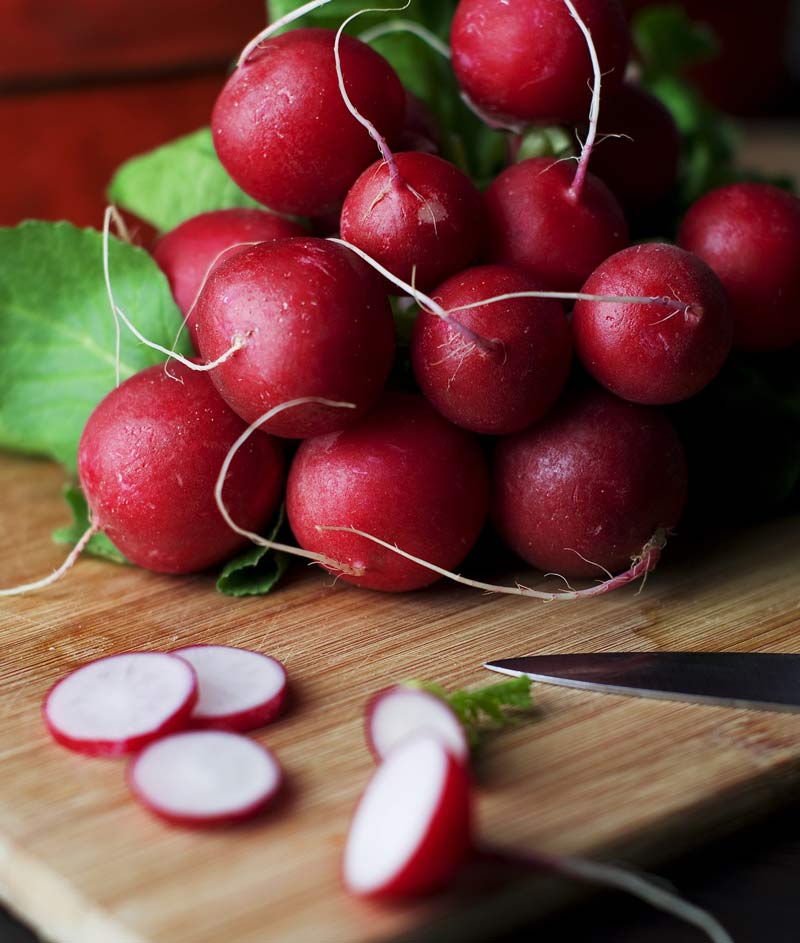Radishes are among the easiest of vegetables to grow and mature in a very short amount of time, usually just over a month to maturity (35-45 days, longer for some of the giant radish varieties). A sure fire success with children because of their fast germination and quick production, kids love to harvest the bright colored, crunchy bouquets of small roots. Radishes have some of the longest history of any vegetables as documented cultivation started in Mediterranean cultures over 4000 years ago! While we don’t have any at Anderson’s that have been around for that long, we carry multiple varieties that we have sold since our earliest days in the seed business - 1942!
Soil Preparation
Radishes prefer a sandy soil, rich in organic matter, well drained, and not too heavy. They also need full sun exposure. Before planting, incorporate 1-2 inches of well composted organic matter, Humic, and 1 lb. of all-purpose fertilizer (we recommend “That’s all it Takes” complete fertilizer or Happy Frog Organic Tomato & Vegetable Food) per 100 square feet and work them in to a depth of 4-6 inches. Heavy, clay-based soils must be amended with compost and organic matter to encourage and allow for good root development. For best results, add 2-4 inches of a variety of different types of organic matter and 50 lbs. of Zeolite soil conditioner per 100 square feet each fall for multiple years to increase drainage and nutrient availability. By doing this yearly, over time you can create a better growing environment for your garden plants to thrive in and produce. Please consult our Soil Preparation Guide in the attached appendix.
Planting
Radishes are almost always grown from seed and can be sown directly outside anytime after the soils reach 40 degrees. Optimal seed germination is at 40-60 degrees, so the best time to plant in Cache Valley is in March and April, and again in August and September for a fall crop. Plant seeds about 1/4-1/2 inch deep and cover with a light mulch, potting soil, or Coconut Coir (just a thin layer 1/4-1/2 inch deep) to prevent soil crusting and to help retain moisture. Try to maintain uniform soil moisture for 7-10 days or until the seeds begin to emerge. As the seedlings begin to grow, thin the plants out to 1-2 inches apart in the rows, and 12-18 inches between rows. If the plants are too close together, the roots will not mature properly. Radishes prefer cool, moist weather, too much heat and they will become hot & peppery in flavor, hollow and grainy in texture, and will almost instantly go to seed.
Varieties
Radishes are best known for the color of their roots, and in many cases, that is where their names are derived also. Sparkler and French Breakfast have a white bottom, and red top to its root, but are differentiated by their shapes: Sparkler is round and French Breakfast is long and cylindrical. Cherry Belle and Crimson Giant are the most common of all red varieties. Icicle and White Globe are completely white. For fun, try growing Watermelon Radish - it’s white on the outside and red in the interior. Most of the varieties we carry at Anderson’s are heirlooms that we’ve sold continuously for 80 years.
Water
Radishes need regular water and consistent soil moisture to produce well. If Mother Nature doesn’t provide cool, moist weather in March and April, use of a soaker hose and light mulches can assist in maintaining correct soil moisture and guaranteeing a healthy harvest. We recommend about 1-2 inches of water applied per week in 2-3 applications. Moisture fluctuations can cause root cracking, slow leaf development, and poor yields. Maintaining consistent moisture will prevent a loss of quality and taste (they go hot and pithy if stressed) and assist in proper root development.
Fertilizer
Since radishes mature so quickly, make sure to apply a balanced vegetable food (“That’s All it Takes” or Happy Frog Organic Tomato & Vegetable Food) down the row of seeds when planting. 1-2 cups per 10 feet of row works well. We recommend the Tomato & Vegetable Food because it contains many micro-nutrients (like Boron & Iron) and beneficial microbes and mycorrhizae that increase water and nutrient uptake and encourage higher and better quality yields.
Common Problems
Radishes grow about as fast as the weeds do, but they also don’t like to compete with weeds either and therefore weed control is vital to their success. Hand weed when necessary, but definitely use pre-emergent weed controls (Treflan or Corn Gluten) before or after germination to prevent new weed emergence. Treflan can be used at the time of planting without affecting radish germination. It saves so much work, don’t hesitate to use it. Flea beetles and aphids commonly attack radish leaves and leave distinctive damage behind that can alert the observant gardener to their presence. Several safe and effective chemical and organic controls are available to stop these pests before they start - Fertilome Spinosad spray is an excellent organic choice, and Ferti-lome Hi-Yield Indoor/Outdoor Insecticide works quickly and safely to stop a wide variety of insects. The most destructive insect to attack turnips is the Cabbage root maggot. These grubs love to eat radish roots and do a lot of damage in the process. Prevent them by treating the soil at planting with Garden, Pet, and Livestock Dust or HiYield Insect Control Granules. Another successful method is to plant the radishes as a fall crop, in late July or August, and the life cycle of the Cabbage maggots is over, and you will have grub-free radishes. A row cover will also stop the insects from attacking the plants or laying eggs, and is a very effective way to stop them entirely.

